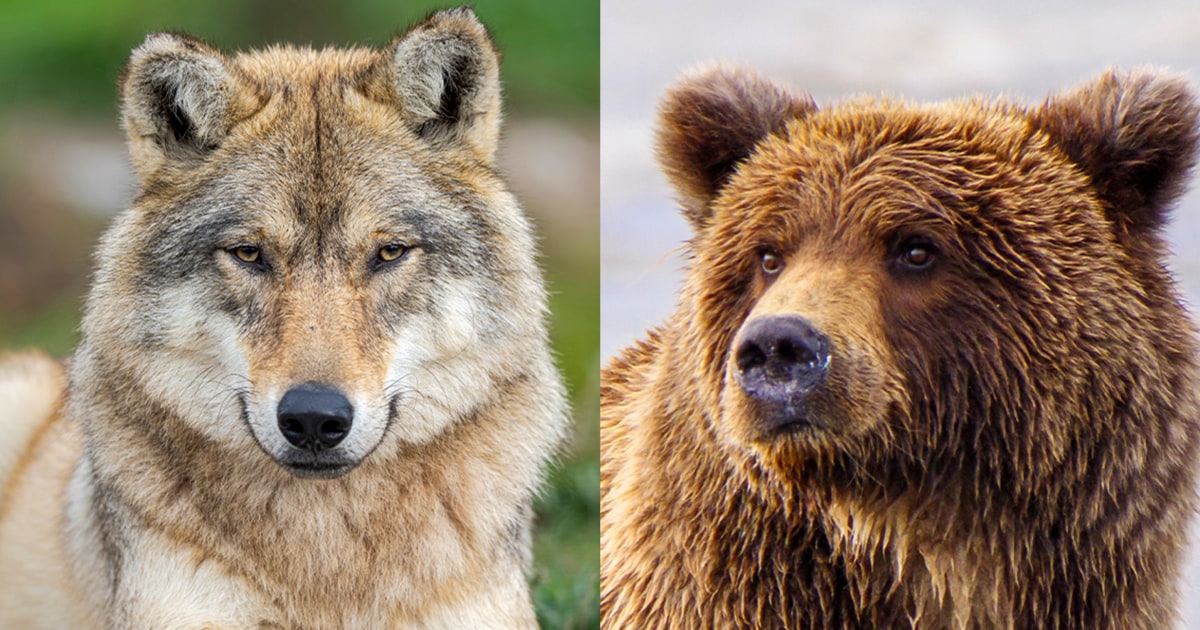Opinion | Why environmentalists are particularly anxious about Project 2025


Trump’s Potential Second Term and the Threat to Endangered Species

Although former President Donald Trump has publicly distanced himself from the conservative Heritage Foundation’s infamous Project 2025 plan, we should take seriously much of what the 920-page document tells us about a potential second Trump term.
Removal of Endangered Species Protections
- If Trump wins in November, federal protections for grizzly bears, gray wolves, and the greater sage grouse may be ended.
- The Project 2025 plan proposes removing these three animals from the federal government’s list of endangered species.
A politically-motivated group making decisions about protected and endangered species has the potential to create a ripple effect of problems.
Environmental groups warn that removing the species from protected lists would expose them to hunting and traps meant to protect farms and ranches, while also leading to the loss of critical habitat.
As Andrea Zaccardi, a carnivore conservation legal director for the Center of Biological Diversity, points out, “The proponents of Project 2025 don’t understand that the protection of species is supposed to be a science-based decision and not a political one.”
The Endangered Species Act and Delisting
- The Endangered Species Act, signed into law by President Richard Nixon in 1973, allows the federal government to protect species at risk of extinction.
- Delisting endangered species is supposed to be done when federal scientists deem it no longer necessary.
- Grizzly bears serve as an example of the political nature of delisting decisions.
Before western expansion, the lower 48 states had over 50,000 grizzly bears. However, by 1975, when they were listed as an endangered species, the number had dropped below 1,000.
Efforts to reintroduce grizzlies in Montana and the states around Yellowstone National Park have been successful, with the population rebounding. However, the population in Washington state and Idaho has not improved significantly.
Ivan London, a senior attorney at Mountain States Legal Foundation, argues that the grizzly bear should have never been listed under the Endangered Species Act. He believes the government should have considered the overall number of grizzlies in the entire United States instead of dividing them into separate ecosystems.
The Role of State Governments
If the three species were delisted, the federal government would no longer have any say in protecting them, leaving the responsibility to state governments.
Idaho and Wyoming already passed laws that would allow trophy hunting of grizzly bears if they are delisted.
However, there are concerns about whether state governments would take strong enough action to protect the species. Incentives for state lawmakers to allow more killing of grizzlies and gray wolves, which can attack livestock, could outweigh conservation efforts.
Mark Jones, national director for hunter outreach for Gun Owners of America, argues that the grizzly bear populations have rebounded enough to be delisted. He believes that keeping them listed is due to national politics interfering with science.
The Threat to Endangered Species
For now, grizzlies, gray wolves, and the sage grouse are protected from trophy hunters, ranchers, and real-estate developers. However, if Trump wins in November, politics could control an already politically charged policy, putting these species at risk.
Ultimately, while some of the species may meet the qualifications for delisting, they are still too fragile for removal. It should be the responsibility of all involved parties to keep animals under protection until science says it isn’t needed — not left to political manifestos and economics.
SDGs, Targets, and Indicators
| SDGs | Targets | Indicators |
|---|---|---|
| SDG 15: Life on Land | Target 15.5: Take urgent and significant action to reduce the degradation of natural habitats | Indicator 15.5.1: Red List Index |
| SDG 15: Life on Land | Target 15.5: Take urgent and significant action to reduce the degradation of natural habitats | Indicator 15.5.2: Reducing the rate of loss of all natural habitats |
| SDG 15: Life on Land | Target 15.9: By 2020, integrate ecosystem and biodiversity values into national and local planning, development processes, poverty reduction strategies, and accounts | Indicator 15.9.1: Progress towards national targets established in accordance with Aichi Biodiversity Target 2 of the Strategic Plan for Biodiversity 2011-2020 |
| SDG 15: Life on Land | Target 15.c: Enhance global support for efforts to combat poaching and trafficking of protected species | Indicator 15.c.1: Proportion of traded wildlife that was poached or illicitly trafficked |
1. Which SDGs are addressed or connected to the issues highlighted in the article?
SDG 15: Life on Land
The issues highlighted in the article are connected to SDG 15, which focuses on protecting, restoring, and promoting sustainable use of terrestrial ecosystems, sustainably managing forests, combating desertification, and halting biodiversity loss.
2. What specific targets under those SDGs can be identified based on the article’s content?
Target 15.5: Take urgent and significant action to reduce the degradation of natural habitats
The article discusses the potential removal of grizzly bears, gray wolves, and the greater sage grouse from the federal government’s list of endangered species. This action could lead to the degradation of their natural habitats.
Target 15.9: By 2020, integrate ecosystem and biodiversity values into national and local planning, development processes, poverty reduction strategies, and accounts
The article mentions the importance of considering the protection of species as a science-based decision rather than a political one. It highlights the need to integrate ecosystem and biodiversity values into planning and development processes.
Target 15.c: Enhance global support for efforts to combat poaching and trafficking of protected species
The article discusses the potential impact of delisting the three species on trophy hunting and the killing of grizzlies and gray wolves. This highlights the need to enhance global support to combat poaching and trafficking of protected species.
3. Are there any indicators mentioned or implied in the article that can be used to measure progress towards the identified targets?
Indicator 15.5.1: Red List Index
The article mentions the potential removal of grizzly bears, gray wolves, and the greater sage grouse from the federal government’s list of endangered species. This action could impact the Red List Index, which measures the conservation status of species.
Indicator 15.5.2: Reducing the rate of loss of all natural habitats
The potential degradation of natural habitats due to the removal of species from the endangered list could impact the rate of loss of natural habitats.
Indicator 15.9.1: Progress towards national targets established in accordance with Aichi Biodiversity Target 2 of the Strategic Plan for Biodiversity 2011-2020
The article emphasizes the importance of considering the protection of species as a science-based decision. This aligns with the Aichi Biodiversity Target 2, which aims to integrate biodiversity values into planning and development processes.
Indicator 15.c.1: Proportion of traded wildlife that was poached or illicitly trafficked
The article discusses the potential impact of delisting the three species on trophy hunting and the killing of grizzlies and gray wolves. This highlights the need to measure the proportion of traded wildlife that is poached or illicitly trafficked.
4. Table: SDGs, Targets, and Indicators
| SDGs | Targets | Indicators |
|---|---|---|
| SDG 15: Life on Land | Target 15.5: Take urgent and significant action to reduce the degradation of natural habitats | Indicator 15.5.1: Red List Index |
| SDG 15: Life on Land | Target 15.5: Take urgent and significant action to reduce the degradation of natural habitats | Indicator 15.5.2: Reducing the rate of loss of all natural habitats |
| SDG 15: Life on Land | Target 15.9: By 2020, integrate ecosystem and biodiversity values into national and local planning, development processes, poverty reduction strategies, and accounts | Indicator 15.9.1: Progress towards national targets established in accordance with Aichi Biodiversity Target 2 of the Strategic Plan for Biodiversity 2011-2020 |
| SDG 15: Life on Land | Target 15.c: Enhance global support for efforts to combat poaching and trafficking of protected species | Indicator 15.c.1: Proportion of traded wildlife that was poached or illicitly trafficked |
Source: msnbc.com








